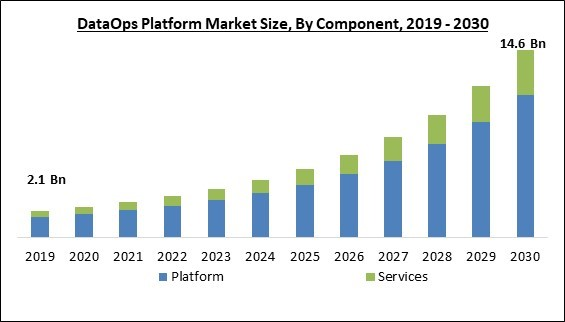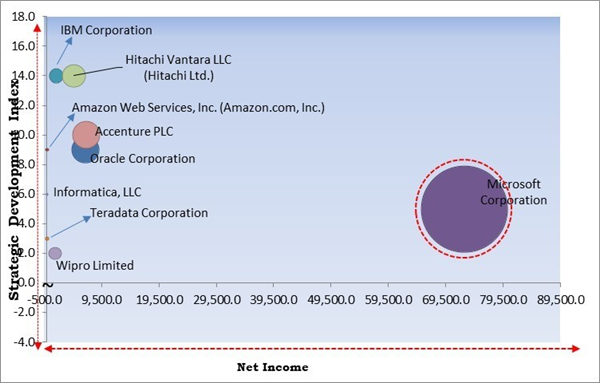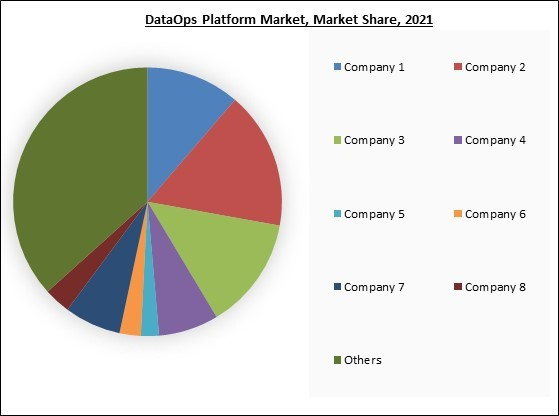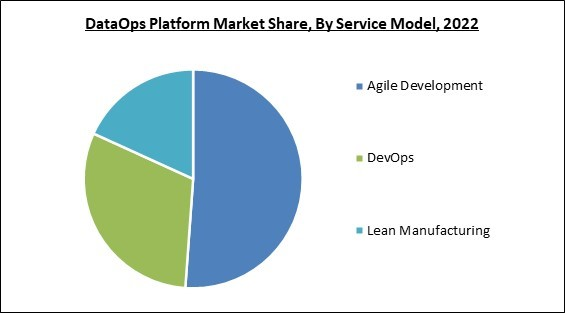The Global DataOps Platform Market size is expected to reach $14.6 billion by 2030, rising at a market growth of 21.2% CAGR during the forecast period.
Asia Pacific region is the most promising region for DataOps platforms due to several causes, including the exponential expansion of big data, the popularity of cloud computing, and the development of artificial intelligence. Hence, Asia Pacific acquired $892.1 million revenue in the market in 2022. In addition, businesses are looking for automated solutions to manage their data effectively due to the unprecedented growth in data volumes to cut costs, enhance operational efficiency, and improve data quality. In the Asia Pacific region, the DataOps platform business environment is broad and continuously changing. It includes a wide range of technology manufacturers, service providers, and consulting companies that offer enterprises complete end-to-end data management solutions.
The major strategies followed by the market participants are Product Launches as the key developmental strategy in order to keep pace with the changing demands of end users. For instance, In May 2023, IBM announced the launch of the Watsonx Platform, a data platform used for increasing the effect of AI and features IBM Watsonx.ai used for testing and deploying new AI capabilities, IBM Watsonx.data, a data store used for governed data, and IBM Watsonx.governance, an AI-powered workflow enabler. Additionally, In May 2023, Hitachi Vantara announced the launch of Data Reliability Engineering (DRE), a collection of services used for enhancing the uniformity and quality of important business data. It features metadata engineering, data cost optimization, AI-powered automation, and data lineage for providing complete transparency and reliability throughout the data lifecycle.
Based on the Analysis presented in the The Cardinal Matrix; Microsoft Corporation is the major forerunner in the Market. In October 2022, Microsoft announced the launch of ArcBox for DataOps. ArcBox for DataOps is a data-based service used for the automation of deployment of different business operations. The service features Azure Infrastructure and integrations and three Kubernetes clusters. Companies such as Hitachi Vantara LLC, Accenture PLC, Oracle Corporation are some of the key innovators in the Market.
The leading players in the market are competing with diverse innovative offerings to remain competitive in the market. The above illustration shows the percentage of revenue shared by some of the leading companies in the market. The leading players of the market are adopting various strategies in order to cater demand coming from the different industries. The key developmental strategies in the market are Product Launches and Product Expansions.
The market research report covers the analysis of key stake holders of the market. Key companies profiled in the report include Microsoft Corporation, IBM Corporation, Oracle Corporation, Amazon Web Services, Inc. (Amazon.com, Inc.), Informatica, LLC, Teradata Corporation, Wipro Limited, Accenture PLC, SAS Institute, Inc. and Hitachi Vantara LLC (Hitachi Ltd.)
Asia Pacific region is the most promising region for DataOps platforms due to several causes, including the exponential expansion of big data, the popularity of cloud computing, and the development of artificial intelligence. Hence, Asia Pacific acquired $892.1 million revenue in the market in 2022. In addition, businesses are looking for automated solutions to manage their data effectively due to the unprecedented growth in data volumes to cut costs, enhance operational efficiency, and improve data quality. In the Asia Pacific region, the DataOps platform business environment is broad and continuously changing. It includes a wide range of technology manufacturers, service providers, and consulting companies that offer enterprises complete end-to-end data management solutions.
The major strategies followed by the market participants are Product Launches as the key developmental strategy in order to keep pace with the changing demands of end users. For instance, In May 2023, IBM announced the launch of the Watsonx Platform, a data platform used for increasing the effect of AI and features IBM Watsonx.ai used for testing and deploying new AI capabilities, IBM Watsonx.data, a data store used for governed data, and IBM Watsonx.governance, an AI-powered workflow enabler. Additionally, In May 2023, Hitachi Vantara announced the launch of Data Reliability Engineering (DRE), a collection of services used for enhancing the uniformity and quality of important business data. It features metadata engineering, data cost optimization, AI-powered automation, and data lineage for providing complete transparency and reliability throughout the data lifecycle.
The Cardinal Matrix - Market Competition Analysis
Based on the Analysis presented in the The Cardinal Matrix; Microsoft Corporation is the major forerunner in the Market. In October 2022, Microsoft announced the launch of ArcBox for DataOps. ArcBox for DataOps is a data-based service used for the automation of deployment of different business operations. The service features Azure Infrastructure and integrations and three Kubernetes clusters. Companies such as Hitachi Vantara LLC, Accenture PLC, Oracle Corporation are some of the key innovators in the Market.
Market Growth Factors
Rising data complexity and volumes
Organizations have to cope with ever-increasing amounts of data from many sources, in structured and unstructured formats, as well as real-time data streams. The quantity, velocity, and diversity of data frequently make it difficult for traditional data management techniques to keep up, which causes inefficiencies, mistakes, and delays in data processing and analysis. Organizations may integrate, process, and analyze data effectively with the help of DataOps platforms, which provide the required tools and technology to handle this complexity. Platforms for data operations can enable both batch processing and real-time data streaming. These factors are fueling the growth of the market.The rising adoption of cloud-native DataOps
Despite the fact that cloud-native DataOps is still a relatively new development in the market for DataOps platforms, it is quickly overtaking other approaches as more companies look to modernize their data operations. Creating and deploying data pipelines and processes on cloud computing platforms is the foundation of this strategy. One of the main advantages of cloud-native DataOps is scalability. Cloud technology enables quick resource expansion, so organizations can manage large volumes of data without worrying about infrastructure restrictions. This is anticipated to promote the use of the DataOps platform by different end users, propelling the market expansion.Market Restraining Factors
Need to address the challenges posed by the talent shortage
The need for more highly competent professionals is one of the most significant obstacles in the market. DataOps platforms necessitate data science, data engineering, software development, and operations experts. However, there is a talent gap due to a severe shortage of professionals with these specific skills. As a result, organizations are having trouble locating qualified candidates to design, implement, and maintain DataOps platforms. In addition, the rapid velocity of technological development is exacerbating this talent gap. As a result, existing team members may require additional or retraining to acclimate to the DataOps methodology.The leading players in the market are competing with diverse innovative offerings to remain competitive in the market. The above illustration shows the percentage of revenue shared by some of the leading companies in the market. The leading players of the market are adopting various strategies in order to cater demand coming from the different industries. The key developmental strategies in the market are Product Launches and Product Expansions.
Component Outlook
Based on component, the market is segmented into platform and services. The platform segment dominated the market with maximum revenue share in 2022. The segment growth is due to its usage to address issues with inefficient data production and processing and poor data quality brought on by mistakes and inconsistencies. It gives everyone in the supply chain access to agile software for data curation, governance, management, and provisioning that is integrated and optimized throughout the full data lifetime.Service Model Outlook
On the basis of service model, the market is divided into agile development, DevOps and lean manufacturing. The DevOps segment procured a substantial revenue share in the market in 2022. This is because DataOps uses DevOps tools to convert data insights into outputs for production. In addition, real-time monitoring is a feature of these technologies that aid in optimizing the data pipelines. Moreover, the DevOps principles aid in smoothly implementing the inputs supplied by the user and business teams. Thus, such features of the DevOps are anticipated to surge the segment's expansion in the projected period.Deployment Outlook
By deployment, the market is classified into cloud and on-premise. The cloud segment witnessed the largest revenue share in the market in 2022. The segment's growth results from the adoption of cloud deployment, which allows customers to access the DataOps platform from any location with an internet connection, increasing flexibility and accessibility. Businesses may now take advantage of the platform's capabilities without being constrained by physical location owing to the improved accessibility.Cloud Type Outlook
Under the cloud type, the market is divided into public cloud, private cloud, and hybrid cloud. The public cloud segment led the market with maximum revenue share in 2022. This is because the most prevalent form of cloud computing deployment is public clouds. The provider owns and manages the hardware, software, and other supporting infrastructure with a public cloud. With the public cloud, users only pay for their services and don't need to buy hardware or software. No maintenance is required with the public cloud. In addition, on-demand resources are available to match business needs, providing nearly infinite scalability.Vertical Outlook
Based on the vertical, the market is bifurcated into BFSI, healthcare & dental, retail, manufacturing, government, IT & telecommunications, energy & utilities, media & entertainment and others. The IT & telecommunication segment recorded a significant revenue share in the market in 2022. This is because fast and secure access to data is essential to provide exceptional, differentiating consumer experiences while operating at a large scale. In addition, telecom operators can supply enterprise data safely and effectively for projects like cloud migration while safeguarding private customer data by implementing a DevOps data platform.Regional Outlook
Region-wise, the market is analyzed across North America, Europe, Asia Pacific, and LAMEA. The North America region led the market by generating the maximum revenue share in 2022. This is due to the region's thriving technology sector and unwavering dedication to innovation and digital transformation. The region's unwavering focus on innovation and digital transformation is the primary factor behind the widespread use of DataOps platforms in North America. Businesses in North America are constantly looking for new strategies to encourage innovation and acquire a competitive edge.The market research report covers the analysis of key stake holders of the market. Key companies profiled in the report include Microsoft Corporation, IBM Corporation, Oracle Corporation, Amazon Web Services, Inc. (Amazon.com, Inc.), Informatica, LLC, Teradata Corporation, Wipro Limited, Accenture PLC, SAS Institute, Inc. and Hitachi Vantara LLC (Hitachi Ltd.)
Strategies Deployed in the Market
Partnerships, Collaborations and Agreements:
- May-2023: Wipro partnered with ServiceNow, a software company based in the USA. The partnership aims to provide the joint clients of the two companies with solutions for business transformation. By doing so, the two companies would be able to serve their customers in a better way.
- May-2022: Oracle announced a partnership with Informatica, an enterprise cloud data management solutions provider. The partnership integrates Oracle's portfolio with Informatica's portfolio and allows their customers to serve their customers in a better way.
- Nov-2021: Amazon Web Services (AWS) teamed up with Goldman Sachs, an investment banking firm to launch Goldman Sachs Financial Cloud for Data. The collaboration allows Amazon Web Services to serve its customers in the financial sector in a better way by providing them with instant analytics in the cloud.
- Nov-2021: Amazon Web Services announced a partnership with Accenture, a professional services company. Through this partnership, the two companies aim to provide their joint customers with cloud-based automation solutions through Accenture AWS Business Group (AABG). The partnership allows AWS to serve its customers in a better way by providing them with innovative solutions.
- Dec-2020: Amazon Web Services (AWS) entered into a partnership with Alation, a data intelligence solutions provider to integrate their data governance and search solutions with AWS services. The partnership allows the two companies to serve their customers in a better way.
- Jun-2020: Microsoft partnered with Hitachi, a Japanese Multinational Corporation, to provide automation solutions for industries in Southeast Asia, Japan, and North America. Through this partnership, Microsoft would be able to serve its customers in a better way by unlocking new opportunities for providing them with solutions.
Product Launches and Product Expansions:
- May-2023: IBM announced the launch of the Watsonx Platform. The Watsonx Platform is a data platform used for increasing the effect of AI. The Watsonx Platform features IBM Watsonx.ai used for testing and deploying new AI capabilities, IBM Watsonx.data, a data store used for governed data, and IBM Watsonx.governance, an AI-powered workflow enabler.
- May-2023: Hitachi Vantara announced the launch of Data Reliability Engineering (DRE). Data Reliability Engineering (DRE) is a collection of services used for enhancing the uniformity and quality of important business data. Data Reliability Engineering (DRE) features metadata engineering, data cost optimization, AI-powered automation, and data lineage for providing complete transparency and reliability throughout the data lifecycle.
- Mar-2023: Teradata introduced Teradata VantageCloud, a cloud-based data analytics platform. The Teradata VantageCloud features Microsoft Azure Machine Learning (Azure ML). The benefits of the product include enhance demand forecast, better risk management, and better patient care.
- Mar-2023: Oracle launched Java 20, an upgraded version of Java. Java 20 is used for delivering security, performance, and stability improvements. The new version features Language improvements such as JEP 432 and JEP 433, Incubator features including JEP 429, JEP 436, and JEP 437, and Project Panama preview features including JEP 434 and JEP 438.
- Nov-2022: Informatica announced the launch of the Intelligent Data Management Cloud (IDMC) platform. The Intelligent Data Management Cloud (IDMC) platform is used for processing transactions and providing insights for the efficient delivery of services by different governments. The benefits of the Intelligent Data Management Cloud (IDMC) platform include quick reaction for crisis and speedy recovery, Enhanced cybersecurity, and a better digital citizen experience.
- Oct-2022: Microsoft announced the launch of ArcBox for DataOps. ArcBox for DataOps is a data-based service used for the automation of deployment of different business operations. The service features Azure Infrastructure and integrations and three Kubernetes clusters.
- Mar-2022: Hitachi Vantara announced new capabilities for Lumada DataOps. The new features include Data Catalog used for enhancing business insights and Data Integration used for combining data across a hybrid cloud.
- Mar-2021: Informatica unveiled the Spark-based Cloud Data Integration engine, used for boosting performance. The Spark-based Cloud Data Integration engine features NVIDIA infrastructure and RAPIDS data science software. Benefits of the Spark-based Cloud Data Integration engine include cost minimization, enhanced data processing speed, and increased data access throughout the organization.
- Dec-2020: Amazon Web Services (AWS) introduced Amazon HealthLake. Amazon HealthLake is a service used for big data analytics in healthcare applications. Amazon HealthLake features interoperability and automated learning for data sorting and identification.
- Nov-2019: Accenture announced the launch of myNav. The myNav is a cloud-based platform used for simulating a variety of cloud solutions. The myNav features multiple variable evaluations used for providing correct solutions to organizations.
- Sep-2019: IBM added new features to Cloud Pak for Data. The new features include AI-powered global search, Automated metadata generation used for classifying and verifying data, AI-powered risk detection of unstructured data, and enhanced connectivity with InfoSphere Advanced Data Preparation.
- Jan-2019: Accenture unveiled SynOps. SynOps is an operating engine used for driving business transformation by enhancing data coordination. The SynOps features Combine human and machine intelligence, Work harmony, diverse data analysis, and Accenture Insights Platform.
Acquisition and Mergers:
- Mar-2023: Accenture announced the acquisition of Flutura, an industrial AI company based in Bangalore. The acquisition enhances Accenture’s industrial AI services for bettering the performance of refineries and plants.
- Jul-2022: IBM took over Databand.ai, a data observability provider headquartered in Israel. This acquisition enables IBM to serve its customers in a better way by providing them with a complete portfolio of services for IT in machine learning and data applications.
- Jun-2022: Oracle announced the acquisition of Cerner, a healthcare information systems supplier. The acquisition provides Oracle with Cerner's portfolio of services and extends its reach in the healthcare sector by allowing them to provide automation solutions to their customers in the healthcare sector.
- Jun-2021: Hitachi Vantara took over Io-Tahoe, a data management solutions provider based in the UK. The acquisition enhances Lumada DataOps Suite by integrating it with Io-Tahoe's AI-powered data management software for driving business transformation. Furthermore, the acquisitions enhance Hitachi Vantara's ability to serve its customers in a better way by providing them with better solutions for business transformation.
- Dec-2020: IBM acquired Instana, an organization performance monitoring platform. This acquisition allows IBM to provide its customers with leading AI-enabled automation powers. Furthermore, this acquisition enhances IBM's Watson AIOps offering.
- May-2020: Hitachi Vantara acquired Waterline Data, Inc., a data cataloging solutions provider. The acquisition strengthens Hitachi Vantara's DataOps solution and enables the company to serve its customers in a better way by providing them with solutions for managing their data assets in multiple environments.
Scope of the Study
By Deployment
- Cloud
- Public Cloud
- Private Cloud
- Hybrid Cloud
- On-premise
By Service Model
- Agile Development
- DevOps
- Lean Manufacturing
By Component
- Platform
- Services
By Vertical
- BFSI
- IT & Telecommunication
- Retail
- Media & Entertainment
- Healthcare & Dental
- Energy & Utilities
- Manufacturing
- Government
- Others
By Geography
- North America
- US
- Canada
- Mexico
- Rest of North America
- Europe
- Germany
- UK
- France
- Russia
- Spain
- Italy
- Rest of Europe
- Asia Pacific
- China
- Japan
- India
- South Korea
- Singapore
- Malaysia
- Rest of Asia Pacific
- LAMEA
- Brazil
- Argentina
- UAE
- Saudi Arabia
- South Africa
- Nigeria
- Rest of LAMEA
Key Market Players
List of Companies Profiled in the Report:
- Microsoft Corporation
- IBM Corporation
- Oracle Corporation
- Amazon Web Services, Inc. (Amazon.com, Inc.)
- Informatica, LLC
- Teradata Corporation
- Wipro Limited
- Accenture PLC
- SAS Institute, Inc.
- Hitachi Vantara LLC (Hitachi Ltd.)
Unique Offerings
- Exhaustive coverage
- The highest number of Market tables and figures
- Subscription-based model available
- Guaranteed best price
- Assured post sales research support with 10% customization free
Table of Contents
Chapter 1. Market Scope & Methodology
Chapter 2. Market Overview
Chapter 3. Competition Analysis - Global
Chapter 4. Global DataOps Platform Market by Deployment
Chapter 5. Global DataOps Platform Market by Service Model
Chapter 6. Global DataOps Platform Market by Component
Chapter 7. Global DataOps Platform Market by Vertical
Chapter 8. Global DataOps Platform Market by Region
Chapter 9. Company Profiles
Companies Mentioned
- Microsoft Corporation
- IBM Corporation
- Oracle Corporation
- Amazon Web Services, Inc. (Amazon.com, Inc.)
- Informatica, LLC
- Teradata Corporation
- Wipro Limited
- Accenture PLC
- SAS Institute, Inc.
- Hitachi Vantara LLC (Hitachi Ltd.)
Methodology

LOADING...












